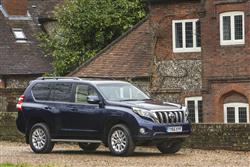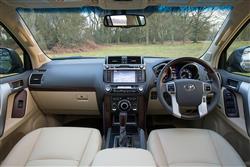This is a sample, showing 30 seconds of each section.
TOUGH LOVE (some text hidden) SECTIONED_toyotalandcruiser3_d-4d060714
By Jonathan Crouch
Introductionword count: 64
Toyota's Land Cruiser has always been the preferred mode of transport in some of the world's harshest environments - and is particularly popular in its more accessible 'Light Duty Series' form. A fourth generation 'J150' version of this model series arrived in 2009 and was substantially improved in 2014 to create the car we're going to look at here as a potential used buy.
Modelsword count: 10
3/5 door family 4x4 (3.0/2.8 D-4D diesel [Active, Icon, Invincible])
Historyword count: 224
In an age of Crossovers, soft roaders and various other permutations of pretend 4x4s, it's refreshing once in a while to come across the real thing. And this is it. Toyota's Land Cruiser. We're looking here at a modern version of the so-called 'Light Duty Series' model, which launched in fourth generation 'J150'-series guise in 2009. To begin with, it sold alongside a larger V8 diesel-powered super-luxury Land Cruiser that sold to the Range Rover set, but in 2014, Toyota's UK importers decided to discontinue that bigger V8 model and focus instead on the 'Light Duty Series' J150 Land Cruiser model range. To suit that remit, the J150 was made smarter and more luxurious as part of a facelift. It's that facelifted model, which sold between 2014 and early 2018, that we examine here as a used buy. Base versions were available with three doors and a short wheelbase bodystyle, but almost all buyers wanted the five-door long wheel base body shape, offered with five seats in lesser guises but with seven seats further up the range. Initially, buyers were offered the 3.0-litre version of Toyota's D-4D four cylinder diesel that'd been used previously by the J150, but in 2015, that was replaced by a slightly more efficient 2.8-litre version of the same unit. The car was facelifted again for the 2018 model year.
What You Getword count: 1429
In a world of stylised luxury SUVs, there's something about this Land Cruiser's bluff-fronted suitability for purpose that's rather refreshing - if you like that sort of thing. Even some of the aesthetic updates made to the post-2014 facelifted fourth generation 'J150' model we're looking at here have their roots in greater off road practicality. Take the way that the headlamp clusters and daytime running lights form a single unit with the grille, with the entire structure set higher so it's less vulnerable to damage in extreme driving conditions. Then there's the over-sized front bumper's chunky two-step design that further protects the headlights above, yet despite the 20mm that this adds to the front overhang, has been designed so that it doesn't lessen the car's approach angle on a steep slope. Here, we're going to focus on the long wheelbase bodystyle that almost all buyers in this country choose, though we'll point out that the farmers and industrial folk who still like the short wheelbase three-door model might still be able to find one. This bigger bodystyle's profile didn't change with the facelift, though owners familiar with the original version of this MK4 'J150'-series model might notice smarter 17 or 18-inch alloy wheels; maybe also the smaller door mirrors with their integrated LED indicators. Otherwise though, this car in this form remains tough, tall and imposing, with few concessions to style, though the distinctive flat-topped wheelarches, the bold sill line and powerful haunches do catch the eye. At the back, the spare wheel as before hangs temptingly in plain view below the level of the bumper, but at least you do still get a proper one, which is rare enough these days. Further up, there's a more prominent numberplate surround than the original version of this design had, plus redesigned rear lamp clusters with clear lens blocks and red accents. It all looks a little smarter but if you're familiar with this car, then you'll probably be of the opinion that the design time could have been better spent in correcting what is arguably this Land Cruiser's most annoyingly distinctive design cue, the side-opening tailgate, a real pest in tight supermarket carparks. True, to compensate, Toyota has provided an opening tailgate glass section but to get your shopping bags in through the opening it creates is an awful lot of work, so high is the loading lip from the ground. Once you do get stuff inside, the news is mostly all good, with nice little touches like a toolbox that's stowed in its own purpose-designed tailgate compartment. We're going to assume that, like almost all buyers of this long wheelbase model, you want seven seats - though a five seat-only configuration was still offered at the foot of the range. If you do want a model with three rows of chairs, then you probably won't be expecting much carriage capacity with all of them in place. You'll be right: there's just 104-litres. Switch to the more common five-seat configuration though and of course things improve markedly. One of the big advantages of choosing this four cylinder 'Light Duty Series' Land Cruiser model rather than its larger, ritzier V8 stablemate is that when you're not using the third row seats, they don't have to be stored vertically on each side of the cargo area, Land Rover Defender-style, when not in use. Instead, they fold properly into the boot floor with a clever 'Easy Flat' arrangement that on mid or high-spec models works at the press of a button. Even the headrest stows itself automatically. Neat. It'll all be welcome for anyone who has broken fingernails or drawn blood battling with rear seat folding mechanisms. For families, it'll be a major selling point. Once the third row seating disappears, a 621-litre space is revealed, big enough to swallow four large suitcases and equipped with a luggage net, tie-down hooks, a 220V AC power outlet, a storage tray, a 3.8-litre storage box and, on most models, a sliding rail system too. You can extend it too, by pushing forward a 40:20:40-split middle bench that has 125mm of sliding travel. If that's still not enough, dropping forward that bench frees up 974-litres of total capacity - less than you get with most rivals in this configuration but quite as much as most families will need. So the square boxy shape gives you plenty of carriage capacity - as you'd have expected. But how will it be for people? Is this car really a realistic alternative to a 7-seat large MPV? Possibly. An SUV is never going to be as invitingly spacious for third row folk as a big People Carrier would be because all those 4WD mechanicals raise the ride height. You realise that stepping up into this thing. Even on top 'Invincible' models with air suspension that can be lowered to ease access, the 2.5cm drop provided doesn't make much difference, though the side step and the way the folded seat angle here has been increased to aid access are both welcome touches. Once you do get yourself back into the third row, you'll certainly find it better than the kids-only zone offered by most cars of this kind. Cup holders and a power socket are provided for junior folk but two adults could happily cope in the very back, provided they weren't too tall and the journey wasn't too long, thanks in part to the way that on mid to high-spec models, you can electrically recline the seats for greater comfort. Of course, if there are adults at the very back, second row folk will need to considerately position their sliding bench to suit those people's needs. The second row seatback reclines too and there's excellent standards of head and legroom. Plenty of practicality too, with seatback pockets, twin cupholders and door pockets with bottle holders. As usual, if you're trying to take three adults, the middle person will have pulled the short straw but three children will be quite happy here. Especially in a top 'Invincible' model with its drop-down DVD screen. At the wheel, as ever, it's more about durability than style but everything's of high quality. We think the wood and plastic mix on top versions could be better judged, but the Piano Black and aluminium detail finishes introduced around the cabin as part of the post-2014 facelift package do add a slightly more up-market feel. As you'd expect, you sit high up in a commanding position on six or eight-way adjustable seats - and there are nice touches like a soft-touch kneepad on the side of the centre console. The Land Cruiser's dashboard ergonomics have always been a bid muddled, but at least some attempt was made with this improved model to try and tidy things up. As with the pre-facelifted model, a huge colour screen dominates the middle of the dashboard, but from 2014, Toyota fitted its better and easier-to-use 'Toyota Touch' infotainment system, with a 7-inch display four times sharper than before. The centre console also gained a switch panel that brings together the controls for the on and off-road driving technologies. These include a selector dial for the five-mode Multi-Terrain Select and five-step Crawl Control functions, flanked by switches for the all-wheel drive and Adaptive Variable Suspension. The key change though with this post-2014 facelifted model was the adoption of a 4.2-inch TFT colour screen set between redesigned Optitron thin-needled speedo and rev counter dials in the instrument binnacle and operable by steering wheel controls. It's got a wide range of functions that are especially helpful off road where this display can show you the vehicle body angle, the traction control operation on each wheel and the status of the differential locks. Despite all the improvements, you'll still need plenty of time with the 1,200-page handbook to understand all the rather scattered switchgear: for example, the way that the damper and traction control buttons are located out of sight under the steering wheel. Still, at least reading up will allow you to more easily locate all the various storage options provided for adventurous Land Cruising folk. As well as properly sized door bins with built-in bottle holders and a huge glovebox, there's a centre storage box that's big enough to hold four half-litre bottles and is cooled on most models for better storage of drinks which can then be dispensed to individual cup holders provided in three different sizes. We also like the overhead sunglasses compartment which folds out to reveal a rear conversation mirror allowing parents to better monitor kids in the back.
To see the full road test text contact us on 0330 0020 227
Pictures (high res disabled)
.jpg)
.jpg)
|
.jpg)
|
.jpg)
| |||
.jpg)
|

|
.jpg)
| |||
.jpg)
|
.jpg)
|

|
Scoring (subset of scores)
Category: Crossover or SUV 4x4s
| Performance | |
| Handling | |
| Comfort | |
| Space | |
| Styling, Build, Value, Equipment, Depreciation, Handling, Insurance and Total scores are available with our full data feed. | |



